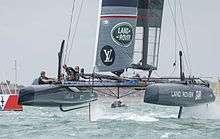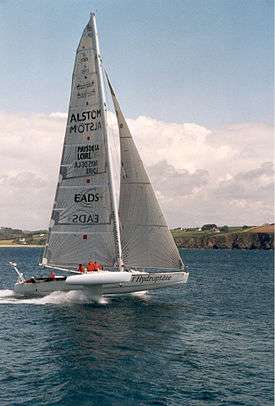Sailing hydrofoil
A sailing hydrofoil, hydrofoil sailboat, or hydrosail is a sailboat with wing-like foils mounted under the hull. As the craft increases its speed the hydrofoils lift the hull up and out of the water, greatly reducing wetted area, resulting in decreased drag and increased speed. A sailing hydrofoil can achieve speeds exceeding twice the wind speed.
Both monohull and multihull sailboats can be retrofitted with hydrofoils, although greater stability can be achieved by using the wider planform of a catamaran or trimaran.
Typical configurations
Some multihulls use three foils; two main forward foils provide lift so that the boat "flies" while a horizontal foil on the rudder is trimmed to drive and control altitude. On catamarans, a single main foil can be attached between the hulls just in front of the center of gravity and at 2 degrees of incidence, spanning the tunnel with supporting struts. Hydrofoil catamarans are also called foilcats.
Multihull sailboats can also employ hydrofoils only to assist performance. Just as daggerboards and rudders are foils that enhance the control of a boat, assisting hydrofoils provide lift to the hull to reduce the wetted area without actually lifting the boat completely out of the water.
Monohull boats typically employ a "ladder" arrangement of hydrofoils splayed out with a dihedral angle of 50 degrees, with a stabilizing rudder foil. One of the earliest examples is the Monitor boat from 1957.[1] This design offers the advantages of maximum lifting foil area at slow speeds and less at higher speeds, with rolling resistance arising from the dihedral support of the outboard ladder foils.
Foiling Classes
International Moth

The most widespread use of hydrofoils in sailboats to date has been in the International Moth class. Andy Paterson of Bloodaxe boats on the Isle of Wight is widely considered to have developed the first functional foiling Moth, though his boat had three foils in a tripod arrangement. Brett Burvill sailed a narrow skiff Moth with inclined surface-piercing hydrofoils to a race win at the Moth World Championships in 2001 in Australia, which was the first time a hydrofoil Moth had won a race at a World Championship. This hydrofoil configuration was later declared illegal by the class, as it was felt to constitute a multihull, which is prohibited by class rules. Initially Ian Ward in Sydney, Australia developed the first centerline foiling Moth which demonstrated that sailing on centerboard and rudder foils alone was feasible. Subsequently, Garth and John Ilett in Perth, Australia developed a two-hydrofoil system for the Moth with active flap control for the main foil via a surface sensor. John's company Fastacraft was the first to produce a commercially available hydrofoil International Moth. Fasta Craft's Prowler design, superseded in 2008 by the F-Zero, features a carbon-fiber hull, inverted "T" foils on the centerboard and rudder, and can reach speeds of over 27 knots. Fasta Craft has since been joined in producing hydrofoil Moths by several other companies, including Bladerider, Assassin, Exocet, and Aardvark Technologies.
Although initially debated fiercely within the class, the adoption of hydrofoils has proven a success for the International Moth class, with rapid fleet growth in the years since 2001. All World Championships since 2004 have been won by hydrofoil-equipped Moths, which can become foilborne in as little as six knots of breeze when steered by an experienced sailor of lighter weight. The class rule remains open to development of all boat components including hydrofoil systems, and development within the class continues to be spurred by both commercial and individual/amateur efforts.
Laser dinghy

The Laser sailing dinghy can be sailed on foils using a clip on retrofit foiling kit developed by Glide Free Design. The first time a Laser foiled was in December 2009 by Ian Ward in Sydney, Australia. Top speeds of around 23-25kts are possible with this kit. The foils can be removed and the boat remains class legal. This foiling system is unique in that it is retractable, has flapless foils and the height sensing 'wand' is integrated within the centerboard.
Catamarans
AC72 and AC45f catamarans

The 2013 America's Cup featured daggerboard catamarans. Under the terms of the protocol, these daggerboards may not feature trim tabs, may not exceed the beam of the boat when raised and may not be adjusted when lowered, but a loophole exploited by three teams was to create T-shaped rudders and L-shaped daggerboards of which the leeward appendage serves as a hydrofoil on all points of sailing conditions in winds over 10 knots. On September 6, 2012 in Auckland, during Team New Zealand's fifth day of trials, their boat achieved circa 40 knots (74 km/h) with a level trim and no heeling with 17 knots of breeze.[2] The 2015–16 America's Cup World Series is being raced with hydrofoiling AC45f catamarans, which are smaller versions of the AC72.
C-Class catamarans
Recent International C-class catamaran have been foiling, and further development is expected.[3]
A-Class catamarans
International A-class catamaran rules initially allowed hydrofoils but were changed to specifically outlaw foils in 2000 after the measurer and president were approached by Jeremy Banks, an Australian sailor, with a hydrofoiling design. Citing reasons of class viability and not wanting to devalue existing boats the rules were re written to specifically outlaw hydrofoils. Over time the situation reversed and the 2014 A Class Catamaran World Titles in Takapuna New Zealand, brought foils to the class.[4]
Nacra 17 catamarans
The Nacra 17 has entered the olympic classes, and is capable of elevated foiling under some conditions.
Nacra F20 catamaran
The F20 is a catamaran similar in design to Nacra's former 20 foot catamaran, however it is made out of carbon fiber and uses curved daggerboards as hydrofoils.
Flying Phantom
The Flying Phantom is a catamaran that uses curved daggerboards as hydrofoils.
Production designs
TriFoiler
In the 1990s the Hobie Cat company manufactured the TriFoiler (no longer in production), a twin-sail trimaran with a mainsail on each outrigger capable of 35+ knot speeds in typical sailing conditions, making the TriFoiler the fastest production sailboat in the world. The prototype of the Hobie TriFoiler, called Longshot, was developed by brothers Dan and Greg Ketterman in conjunction with Russell Long. Though more streamlined than the Trifoiler and having smaller hydrofoils, Longshot still holds the Class A speedsailing record of 43.55 knots on a 500-meter course, set in Tarifa Spain in 1993. Until recently, it was the only existing speedsailing record held by a hydrofoil, but the recent records of Hydroptère have added to the list with record breaking runs across the English Channel.[5]
WindRider Rave
In 1998, WindRider LLC introduced the WindRider Rave,[6] a popular two-person trimaran hydrofoil capable of lifting off in as little as 12-13 knots of wind. The Rave is capable of sailing between 1.5 and 2 times wind speed.[7] The boat's mainsail has no boom. The Rave broke new ground in the development of flapped foils and control systems.
Experimental designs

Non-production experimental designs have been built:
- The French experimental Hydroptère has set numerous speed records. The boat attained a record speed of 47.6 knots[8] with a goal of breaking the "50 knot barrier" in 2008.[9] On 4 September 2009, l’Hydroptère broke the world speed sailing record, sustaining a speed of 51.36 knots for 500m.[10]
- The Vestas Sailrocket 2, a boat specifically built for breaking the world speed sailing record, accomplished this on 18 November 2012, and then broke its own record on 24 November 2012 by sailing 65.45 knots.
- A Hobie 18 foilcat prototype called Kangalope with foil kits attached.[11]
- Mirabaud LX is a Swiss 1.2 meter hydrofoil boat with traditional hull replaced with centerfloat, supporting spar for foil, sail and crew perch similar to moth sailing boat.[12]
- Rich Miller's hydrofoil sailboard.[13]
See also
References
- ↑ "Monitor specs". International Hydrofoil Socieity. Retrieved 2008-06-03.
- ↑ Team NZ's new catamaran in full flight, TVNZ, 2012-09-06
- ↑ Foiling 'Little Cup' Cats set for prestigious C-Class Championship Trophy
- ↑ Worlds @Takapuna: Day 1, Report by Bob Griffits
- ↑ "Hobie TriFoiler History". Retrieved 2008-05-15.
- ↑ "WindRider Rave". Retrieved 2008-05-15.
- ↑ Burns, Thom (1998). "The Rave Hydrofoil". Sailing Breezes online magazine. Retrieved 2008-05-15.
- ↑ "Assault on the World Sailing Speed Record". 2008-02-11. Archived from the original on July 6, 2011. Retrieved 2012-09-09.
- ↑ "l'Hydroptère, new version". 2007-12-14. Archived from the original on April 18, 2009. Retrieved 2012-09-09.
- ↑ "L'Hydroptère, monstre de vitesse". L’Équipe. 2009-09-06. Retrieved 2012-09-09.
- ↑ Carlson, Dave. "Hydrofoil! (Hobie 18 foilcat Kangalope)". Archived from the original on July 21, 2011. Retrieved 2008-05-15.
- ↑ "Mirabaud LX".
- ↑ "The Miller Hydrofoil Sailboard". International Hydrofoil Society. 2007-09-11. Retrieved 2008-05-15.
External links
- Foils.org gallery of sailing hydrofoils
- Miller Hydrofoil Sailboard - a hydrofoil windsurfer experiment
- Sailing Cat with Foils
- Trimaran Foil Assisted
- Aspects of a Foiled Multihull
- Design Forum and information exchange
- Glide Free Foils for the Laser sailing dinghy